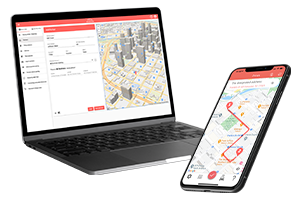Febraury 8, 2024
Navigating the maze of self-employment deductions can feel like an overwhelming task for entrepreneurs and freelancers. From understanding the standard self-employment deduction to maximizing your self-employed expenses deduction, there’s a lot to keep track of.
Fortunately, with the help of technology, deduction trackers or deduction apps can significantly simplify this process, ensuring you capture all deductions for self-employed individuals. Whether you’re trying to decide is it better to deduct gas or mileage using the standard mileage deduction rate, or you’re curious about the nuances of the medical travel tax deduction, this article serves as your comprehensive guide.
We’ll explore the essential deductions for self-employed professionals, offering insights into how to effectively track tax deductions and highlighting the benefits of each self-employment deduction. From the basics of the self-employed expenses deduction to more specific scenarios like leveraging the standard mileage deduction rate, our goal is to demystify the process and help you leverage every possible advantage.
The right deduction apps can transform how you manage your taxes, making it easier than ever to ensure you’re not leaving money on the table. Join us as we dive deep into the world of self-employment deductions, empowering you with the knowledge to secure your financial future.

Understanding Self-Employment Taxes: The Basics You Need to Know
At the heart of self-employment taxes is the concept of covering Social Security and Medicare contributions. Unlike traditional employees, whose contributions are split with their employers, self-employed individuals are responsible for the full amount. This might sound like a hefty burden, but it ensures you’re covered for future benefits. Here’s a simple breakdown:
- Social Security: This provides you with retirement benefits, disability benefits, survivor benefits, and benefits for your dependents.
- Medicare: This covers your hospital and medical insurance once you’re eligible.
The current rate for self-employment tax is 15.3%, comprising 12.4% for Social Security and 2.9% for Medicare. This applies to your net earnings from self-employment.
Deductible Part of Your Self-Employment Tax
A silver lining is that you can deduct the employer-equivalent portion of your self-employment tax when calculating your adjusted gross income. This deduction only affects your income tax, not your net earnings or your self-employment tax amount.
FAQs to Ease Your Mind
- Q: How do I know if I need to pay self-employment tax?
A: If you’ve earned $400 or more from self-employment, you’re required to file. - Q: Can I reduce my self-employment tax?
A: While the tax rate is fixed, you can lower your taxable income by deducting legitimate business expenses, thus reducing your overall tax liability. - Q: What forms do I need for self-employment taxes?
A: You’ll primarily use Form 1040 for your income tax and Schedule SE for self-employment tax. - Q: Is there a way to make paying self-employment tax easier?
A: Yes! Consider making quarterly estimated tax payments to spread out the tax burden and avoid a large lump sum come April.
Strategies for Managing Self-Employment Taxes
- Keep meticulous records of your income and expenses. This not only makes filing easier but can also help you identify deductible expenses.
- Explore deductions like the home office deduction, travel expenses, and more to lower your taxable income.
- Use tax software or consult a tax professional to ensure you’re taking advantage of all possible deductions and credits.
- Consider setting aside a portion of your income in a separate account for tax purposes, so you’re not caught off guard by the payment due.
Understanding self-employment taxes is crucial for anyone stepping into the world of freelancing or starting their own business. By staying informed and prepared, you can ensure that tax season is less of a headache and more of a step toward your financial goals. Remember, investing a little time and effort now can save you a lot of stress and money later on.
Home Office Deductions: Maximizing Your Workspace Savings
Creating a productive workspace in your home not only fuels your efficiency but can also offer significant tax advantages if you’re self-employed. Navigating the home office deduction doesn’t have to be complicated. Let’s break it down into bite-sized pieces so you can confidently claim what’s rightfully yours and keep more money in your pocket.
Home Office Deductions: The Basics
To qualify for a home office deduction, your space must meet two key requirements: it must be used regularly and exclusively for business, and it must be your principal place of business. This means if your kitchen table doubles as your workspace and a spot for family dinners, it won’t qualify. But don’t worry, even if you don’t have a separate room, a clearly delineated area will do just fine.
There are two methods for calculating your home office deduction: the Simplified Option and the Regular Method.
- Simplified Option: You can deduct $5 per square foot of your home used for business, up to 300 square feet, maxing out at $1,500.
- Regular Method: This involves calculating the actual expenses of your home office, including mortgage interest, insurance, utilities, repairs, and depreciation. This method requires more documentation but can lead to a larger deduction.
FAQs to Guide You Through
- Q: Can I take the home office deduction if I’m renting?
A: Absolutely! Renters can also claim the deduction based on the percentage of their home used for business. - Q: What if I use part of my home for business and personal use?
A: The key is the exclusive use for business. However, if you have a separate structure not attached to your home, like a studio, it doesn’t need to be your principal place of business. - Q: How do I decide which method to use?
A: The Simplified Option is great for ease and efficiency, especially if your office is smaller. The Regular Method requires more work but can be worth it for larger spaces with significant expenses.
Making the Most of Your Home Office Deduction
- Measure your space accurately. Whether you’re using the simplified method or calculating actual expenses, knowing the exact size of your home office is crucial.
- Keep detailed records of all your expenses. This includes bills, receipts, and statements related to your home office. It’s better to have it and not need it than to need it and not have it.
- Consider the impact on future sales of your home. Using the Regular Method can lead to a depreciation recapture when you sell your home. Understanding the long-term implications is important.
- Consult with a tax professional. The home office deduction can be complex, and the best choice varies by individual circumstances. A professional can offer personalized advice based on your situation.
Embracing the home office deduction is a smart move for any self-employed individual looking to maximize their tax savings. With a clear understanding of the rules and some careful planning, you can transform your home office into not just a place of productivity, but also a source of tax efficiency. Remember, it’s not just about working smarter; it’s about working smarter with your finances too.
Travel and Transportation: Navigating Deductible Expenses for the Self-Employed

Exploring the mileage deduction options for business purposes not only broadens your horizons but can also lead to significant tax deductions. If you’re self-employed, understanding how to maximize your travel and transportation deductions can transform your next business trip from a financial burden into a savvy investment. Let’s dive into the essentials, making this topic as exciting as planning your next business adventure.
Travel and Transportation Deductions: The Essentials
For the self-employed, nearly every mile and hotel night can count towards your deductions, provided they’re strictly for business purposes. Here are the key points:
- Travel expenses include airfare, hotel accommodations, car rentals, and even meals during business trips away from your tax home (your regular place of business).
- Transportation expenses cover the costs of getting to and from your place of business. This could mean the cost of visiting clients, going to a business meeting, or even driving to a business-related event.
The IRS is pretty generous here, but they also expect you to keep detailed records. Let’s break down what you can deduct and how to keep Uncle Sam happy.
FAQs to Fuel Your Knowledge
- Q: What counts as a deductible travel expense?
A: Deductible travel expenses include public transportation fares, parking fees, tolls, taxis, and the business use portion of your personal vehicle expenses. - Q: Can I deduct meals while traveling?
A: Yes, meals during business travel are deductible, but only 50% of the meal expenses are allowed by the IRS. - Q: How do I track mileage for deductions?
A: Keep a detailed log of your mileage, including the date, destination, purpose of your trip, and the miles driven. There are also several apps designed to make this easier. We recommend MileageWise that offers you 100% IRS-Proof logs, tax preparation and audit protection services.
Maximizing Your Deductions
- Know what qualifies. Not all travel and transportation costs are deductible. Commuting between your home and regular workplace, for example, is not deductible.
- Use the standard mileage rate or actual expenses for vehicle deductions. The standard mileage rate simplifies record-keeping by allowing you to multiply the miles driven for business by a set rate. Alternatively, you can calculate the actual expenses of operating your vehicle, including gas, maintenance, and depreciation.
- Leverage technology. Use apps and tools designed for tracking travel and transportation expenses. They can simplify record-keeping and ensure you’re capturing every deductible expense.
- Stay organized. Keep all receipts and logs related to business travel and transportation. Digital copies are fine, but they must be readily accessible for tax purposes.
Understanding travel and transportation deductions can seem complex, but with the right approach, it can be rewarding. Whether you’re zi-zagging across the country for conferences or meeting clients across town, each trip is an opportunity to grow your business and reduce your taxable income.
Download MileageWise’s automatic mileage tracker app from Google Play or the App Store & try it for free for 14 days. No credit card required!
Equipment and Supplies: Investing in Your Business While Saving on Taxes

Diving into the world of self-employment means every decision you make can impact your bottom line, including the investments in equipment and supplies. Fortunately, the tax code offers avenues to recoup some of those costs through deductions. Whether it’s the latest tech gadget that keeps your business running smoothly or the paper and ink that fuel your printer, understanding how to deduct these expenses can significantly reduce your taxable income. Let’s unwrap this package of savings together.
Equipment and Supplies: Unboxing Your Deduction Opportunities
The IRS allows self-employed individuals to deduct the cost of business-related equipment and supplies. This includes computers, printers, software, office furniture, and any other items necessary for your business operations. Here’s the lowdown:
- Equipment: Generally considered a long-term asset, equipment can be deducted through depreciation over several years or, in some cases, immediately through Section 179 or bonus depreciation.
- Supplies: These are items you use and replace more regularly, such as paper, ink cartridges, and small office tools. Supplies can usually be deducted in the year they’re purchased.
FAQs to Equip You with Knowledge
- Q: What’s the difference between deducting and depreciating?
A: Deducting means writing off the full cost of an item in the year it’s purchased. Depreciating spreads the cost across the useful life of the item, offering a deduction over several years. - Q: Can I deduct software subscriptions?
A: Yes, software subscriptions necessary for your business are fully deductible in the year paid. - Q: What about items used for both personal and business purposes?
A: You can only deduct the portion of the cost that is used for business. For example, if you use a laptop 50% for work and 50% for personal use, you can deduct 50% of the cost.
Maximizing Your Deductions for Equipment and Supplies
- Keep detailed records. Save receipts and note the purpose of each purchase. If you use something for both personal and business, keep a log of your usage.
- Understand Section 179. This tax code provision allows you to deduct the full purchase price of qualifying equipment and software purchased or financed during the tax year, subject to certain limits.
- Leverage bonus depreciation. This can be especially beneficial in years when you make significant investments in equipment, as it allows for an immediate deduction of a percentage of the cost.
- Review the tangible property regulations. These rules can help determine whether an expense should be capitalized and depreciated or if it can be expensed in the year of purchase.
Investing in your business is essential for growth, and the tax code provides opportunities to soften the financial impact of these investments. By taking advantage of equipment and supplies deductions, you’re not just saving money; you’re investing back into your enterprise, fueling your journey toward success. Remember, a penny saved in taxes is a penny that can be reinvested in your dreams. Stay informed, stay organized, and watch your business—and deductions—grow.
Health Insurance and Retirement Plans: Leveraging Personal Expenses for Tax Advantages
Embarking on the path of self-employment brings its share of challenges and rewards, with one of the most significant perks being the potential tax advantages tied to health insurance and retirement plans. These deductions can not only provide financial relief but also encourage a healthier, more secure future. Let’s dive into how you can turn these essential expenditures into valuable tax-saving opportunities.
Health Insurance Deductions: A Dose of Financial Wellness
For self-employed individuals, the premiums paid for health, dental, and even long-term care insurance can offer a substantial deduction. This deduction is not just limited to your own coverage but extends to your spouse, dependents, and any children under 27 years old, even if they’re not dependents. Here’s the best part: This deduction is taken on your Form 1040, reducing your adjusted gross income and offering tax benefits even if you don’t itemize deductions.
Retirement Plan Contributions: Investing in Your Future
When it comes to retirement plans, self-employed individuals have several options, including SEP IRAs, SIMPLE IRAs, and solo 401(k)s. Contributions to these plans not only secure your future but also reduce your taxable income for the year. The beauty of these plans is the generous contribution limits, allowing you to save a significant amount for retirement while simultaneously lowering your tax bill.
FAQs to Boost Your Financial Health
- Q: Can I deduct health insurance premiums if I’m eligible for another plan?
A: No, if you or your spouse is eligible for a group health plan through another employer, you can’t deduct premiums for any month covered by that plan. - Q: How much can I contribute to my retirement plan?
A: Contribution limits vary by plan type and tax year. For example, SEP IRAs allow contributions of up to 25% of your net earnings from self-employment, with a cap that adjusts annually for inflation. - Q: Are health savings accounts (HSAs) deductible?
A: Yes, contributions to HSAs are deductible and offer a triple tax advantage: contributions are tax-deductible, the account grows tax-free, and withdrawals used for qualified medical expenses are tax-free.
Maximizing Your Deductions and Securing Your Future
- Keep impeccable records of all health insurance premiums and out-of-pocket medical expenses. This ensures you’re fully leveraging the available deductions.
- Review your retirement saving options annually. Contribution limits and tax laws change, so what worked last year may not be the best choice this year.
- Consider the long-term benefits of an HSA if you have a high-deductible health plan. It’s a powerful tool for both healthcare savings and tax efficiency.
- Consult with a tax professional. Navigating the intricacies of tax deductions for health insurance and retirement plans can be complex. A professional can help tailor a strategy that maximizes your benefits.
Wrapping It Up
As we wrap up our journey through the landscape of self-employment deductions, remember that the key to maximizing your tax savings lies in staying informed and utilizing the right tools. Whether it’s leveraging a deduction tracker app, understanding the nuances of the standard mileage deduction rate, or navigating the complexities of medical travel tax deductions, each strategy we’ve discussed serves as a stepping stone towards optimizing your financial health.
Download MileageWise’s automatic mileage tracker app from Google Play or the App Store & try it for free for 14 days. No credit card required!



